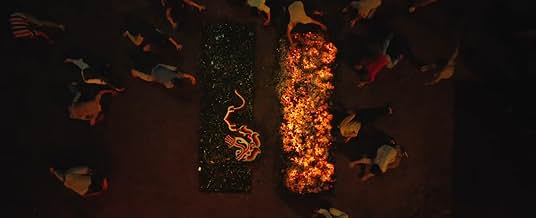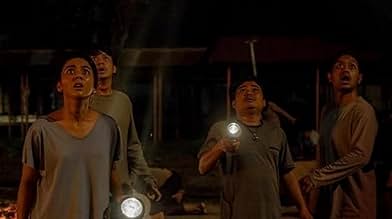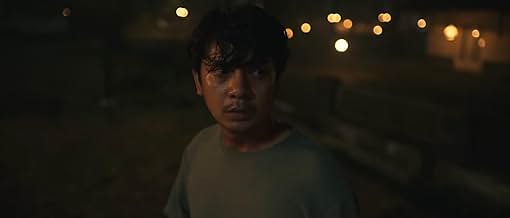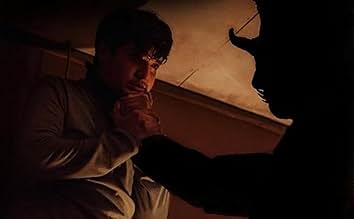IMDb-BEWERTUNG
6,1/10
2434
IHRE BEWERTUNG
Füge eine Handlung in deiner Sprache hinzuA group of seasonal laborers who come to an old sugar factory in the countryside to work during the harvest season.A group of seasonal laborers who come to an old sugar factory in the countryside to work during the harvest season.A group of seasonal laborers who come to an old sugar factory in the countryside to work during the harvest season.
Empfohlene Bewertungen
10RidoG-5
"Pabrik Gula" is strong evidence that local culture can be a source of horror that is no less creepy than the western stories we have seen so often. In this movie, myths and legends rooted in the traditions of the community around the factory become the main foundation of tension. The result is a horror movie that feels very authentic, nuanced, and certainly gripping in a very Indonesian way.
Right from the start, "Pabrik Gula" hints that this place is more than just an old, empty building. There is a deep-rooted dark history, told for generations by the locals. Stories about the spirits of the workers, bloody sacrifices, and supernatural creatures that are said to guard the factory become the backdrop that enriches the atmosphere of the movie. But the greatness of this movie is how all of that is conveyed subtly, unhurriedly, and without explaining everything explicitly. The audience is invited to feel, guess, and imagine for themselves the horrors that might be hidden behind the factory walls.
The use of local mythology does not feel forced. It flows naturally into the narrative, strengthening the characters' motivations and shaping a threat that feels much more real because it is based on beliefs that live in the community. In this way, the fear presented in "Pabrik Gula" becomes a collective fear - something we've all heard from our parents' stories, and because of that, it feels closer and more intimidating.
The acting of the cast really supports this authenticity. They managed to show a different kind of fear: not just fear of what they saw, but fear of something bigger, something that has lived in their culture for a long time. There is a hesitant expression, a deep respect for the supernatural, and sometimes a resigned attitude that shows they know how small humans are in the face of those unseen forces.
The cinematography of the movie reinforces this atmosphere. The camera often captures small elements - forgotten offerings, strange scribbles on the wall, the faint sound of gamelan in the distance - all of which enrich the world of "Sugar Factory" without having to explain it. It's a very clever form of visual storytelling: building a living, breathing world without having to make it feel contrived.
Music and sound design also play an important role in building the mythological atmosphere of the movie. Instead of relying on loud modern scoring, "Pabrik Gula" uses traditional instruments, gamelan sounds, and ancient chants layered with creepy sound effects. This provides an additional layer of authenticity and deepens the impression that what we are witnessing is not just a fictional story, but a reflection of real beliefs and fears.
The story in "Sugar Factory" develops slowly, like a slowly creeping fog. Every little clue about the factory's past, every secret uncovered, brings us closer to the core of the curse that surrounds this place. The movie doesn't offer easy answers; it respects the complexity of myth, where the line between reality and belief is often blurred. This makes for a much richer and evocative viewing experience.
One of the movie's greatest strengths is how it treats the theme of belief with respect. It doesn't mock superstition or treat local beliefs as ridiculous. Instead, it recognizes that myths have power, both in shaping communities and in shaping individual fears. This provides an additional emotional layer that we rarely see in modern horror films.
The ending of the movie is also very satisfying. Without giving too much away, one could say that "Sugar Factory" closes its story with a sense of mythological justice - that everything done in the past must be paid for, that there is a balance to be restored, even if it means going through terror and destruction. It's a bittersweet ending but feels very much in keeping with the feel that has been built up throughout the movie.
Overall, "Sugar Factory" is a horror masterpiece that manages to combine suspense, atmosphere, and the richness of the local culture in a very satisfying way. It is a movie that not only scares, but also invites the audience to reflect on our relationship with the past, with the land we stand on, and with the beliefs that shape who we are.
For anyone looking for a horror movie with depth of theme and a strong local flavor, "Pabrik Gula" is the perfect choice. It is proof that Indonesian horror has its own unique voice - a voice that is creepy, melodious, and truly haunting.
Right from the start, "Pabrik Gula" hints that this place is more than just an old, empty building. There is a deep-rooted dark history, told for generations by the locals. Stories about the spirits of the workers, bloody sacrifices, and supernatural creatures that are said to guard the factory become the backdrop that enriches the atmosphere of the movie. But the greatness of this movie is how all of that is conveyed subtly, unhurriedly, and without explaining everything explicitly. The audience is invited to feel, guess, and imagine for themselves the horrors that might be hidden behind the factory walls.
The use of local mythology does not feel forced. It flows naturally into the narrative, strengthening the characters' motivations and shaping a threat that feels much more real because it is based on beliefs that live in the community. In this way, the fear presented in "Pabrik Gula" becomes a collective fear - something we've all heard from our parents' stories, and because of that, it feels closer and more intimidating.
The acting of the cast really supports this authenticity. They managed to show a different kind of fear: not just fear of what they saw, but fear of something bigger, something that has lived in their culture for a long time. There is a hesitant expression, a deep respect for the supernatural, and sometimes a resigned attitude that shows they know how small humans are in the face of those unseen forces.
The cinematography of the movie reinforces this atmosphere. The camera often captures small elements - forgotten offerings, strange scribbles on the wall, the faint sound of gamelan in the distance - all of which enrich the world of "Sugar Factory" without having to explain it. It's a very clever form of visual storytelling: building a living, breathing world without having to make it feel contrived.
Music and sound design also play an important role in building the mythological atmosphere of the movie. Instead of relying on loud modern scoring, "Pabrik Gula" uses traditional instruments, gamelan sounds, and ancient chants layered with creepy sound effects. This provides an additional layer of authenticity and deepens the impression that what we are witnessing is not just a fictional story, but a reflection of real beliefs and fears.
The story in "Sugar Factory" develops slowly, like a slowly creeping fog. Every little clue about the factory's past, every secret uncovered, brings us closer to the core of the curse that surrounds this place. The movie doesn't offer easy answers; it respects the complexity of myth, where the line between reality and belief is often blurred. This makes for a much richer and evocative viewing experience.
One of the movie's greatest strengths is how it treats the theme of belief with respect. It doesn't mock superstition or treat local beliefs as ridiculous. Instead, it recognizes that myths have power, both in shaping communities and in shaping individual fears. This provides an additional emotional layer that we rarely see in modern horror films.
The ending of the movie is also very satisfying. Without giving too much away, one could say that "Sugar Factory" closes its story with a sense of mythological justice - that everything done in the past must be paid for, that there is a balance to be restored, even if it means going through terror and destruction. It's a bittersweet ending but feels very much in keeping with the feel that has been built up throughout the movie.
Overall, "Sugar Factory" is a horror masterpiece that manages to combine suspense, atmosphere, and the richness of the local culture in a very satisfying way. It is a movie that not only scares, but also invites the audience to reflect on our relationship with the past, with the land we stand on, and with the beliefs that shape who we are.
For anyone looking for a horror movie with depth of theme and a strong local flavor, "Pabrik Gula" is the perfect choice. It is proof that Indonesian horror has its own unique voice - a voice that is creepy, melodious, and truly haunting.
10Yuki-08
Pabrik Gula successfully conveys deep social criticism without losing its cinematic aesthetics. Directed with great visual precision, the film depicts the lives of sugar factory workers with a heart-wrenching yet empathetic narrative. The images of old factories, creaking machines, and the harsh working atmosphere are shown not as documentation, but as symbols of an outdated and suffocating system.
One of the film's strengths lies in its ability to capture the stillness and facial expressions of its characters. There is not much dialog, but the expressions and atmosphere are enough to convey emotion and tension. The minimal background music reinforces the impression of silence and the heavy burden of life borne by the characters.
Pabrik Gula is a movie that gives the audience room to reflect. It does not lecture, but shows clearly-through the daily life behind the walls of an old factory-about inequality, injustice, and human resilience in the face of an unfavorable system.
One of the film's strengths lies in its ability to capture the stillness and facial expressions of its characters. There is not much dialog, but the expressions and atmosphere are enough to convey emotion and tension. The minimal background music reinforces the impression of silence and the heavy burden of life borne by the characters.
Pabrik Gula is a movie that gives the audience room to reflect. It does not lecture, but shows clearly-through the daily life behind the walls of an old factory-about inequality, injustice, and human resilience in the face of an unfavorable system.
10YudaM-7
"Pabrik Gula" is a cinematic work that not only pleases the eye, but also touches the heart in a very profound way. In an era where commercial films compete with grandiose visual effects or sensational stories, "Pabrik Gula" comes across with a simplicity that thrills. The movie tells the story of the lives of workers in an old sugar factory that dates back to colonial times, taking us on an emotional journey of hard work, solidarity, and the struggle to face the changing times.
Since the first minute, "Pabrik Gula" has managed to create a strong atmosphere. The factory setting with its giant machines rattling quietly, the distinctive aroma of sugar that seems to permeate the screen, and the characters with faces full of fatigue and hope are all presented in great detail. It's not just a backdrop for the story, but an integral part that brings the overall atmosphere of the movie to life. Every detail, from the workers' shabby costumes to the sunlight streaming through the factory roof, shows how much the production team loved this project.
The acting of the cast is also superb. Not a single character feels contrived. They play with honest emotion, as if they are truly living in the world of the factory. We can feel the bitterness in their gazes, the weariness in their steps, and the spirit that slowly wears thin, but never really dies out. These characters remind us that behind every product we consume, there are real people struggling to make it happen.
The story of "Sugar Factory" progresses at a calm pace, but never gets boring. Each scene is carefully crafted, building emotions gradually until it reaches a very moving peak. The movie is not about big action or explosive drama, but rather about an inner journey, about everyday struggles that may seem small, but are actually monumental. The main conflict in the movie is rooted in the changing times that threaten the existence of the factory, and with it, the lives of its workers. But instead of presenting it in an overly dramatic manner, "Pabrik Gula" chooses a more humane and realistic approach.
The cinematography of this movie deserves special praise. The use of natural light, precise framing, and the selection of angles that highlight the beauty in obsolescence all feel very poetic. Each shot is like a living painting that tells its own story. The same goes for the sound; the rumbling of machines, the whispered conversations between workers, the clanking of tools, all form a layer of sound that enriches the viewing experience without feeling intrusive.
One of the biggest strengths of "Sugar Factory" is its ability to evoke empathy. The film never explicitly asks us to sympathize with the characters, but through its honest and simple portrayal, we are compelled to care. We see lives that we may never have considered before, and we learn to appreciate their existence.
In addition, the film also offers reflections on social change and industrialization. It reminds us that modernization is not always good for everyone, and that there are traditional values that we should not simply forget. This theme is delivered in a very subtle yet powerful way, making "Pabrik Gula" feel relevant, no matter when and where we watch it.
Overall, "Sugar Factory" is a loving tribute to the little people who built this world with their hands. It teaches us that in this life of change, we should never forget our roots. A movie that is not only worth watching, but also contemplating and feeling deeply. Without a doubt, I rank "Pabrik Gula" as one of the best local films I've seen in recent years.
Since the first minute, "Pabrik Gula" has managed to create a strong atmosphere. The factory setting with its giant machines rattling quietly, the distinctive aroma of sugar that seems to permeate the screen, and the characters with faces full of fatigue and hope are all presented in great detail. It's not just a backdrop for the story, but an integral part that brings the overall atmosphere of the movie to life. Every detail, from the workers' shabby costumes to the sunlight streaming through the factory roof, shows how much the production team loved this project.
The acting of the cast is also superb. Not a single character feels contrived. They play with honest emotion, as if they are truly living in the world of the factory. We can feel the bitterness in their gazes, the weariness in their steps, and the spirit that slowly wears thin, but never really dies out. These characters remind us that behind every product we consume, there are real people struggling to make it happen.
The story of "Sugar Factory" progresses at a calm pace, but never gets boring. Each scene is carefully crafted, building emotions gradually until it reaches a very moving peak. The movie is not about big action or explosive drama, but rather about an inner journey, about everyday struggles that may seem small, but are actually monumental. The main conflict in the movie is rooted in the changing times that threaten the existence of the factory, and with it, the lives of its workers. But instead of presenting it in an overly dramatic manner, "Pabrik Gula" chooses a more humane and realistic approach.
The cinematography of this movie deserves special praise. The use of natural light, precise framing, and the selection of angles that highlight the beauty in obsolescence all feel very poetic. Each shot is like a living painting that tells its own story. The same goes for the sound; the rumbling of machines, the whispered conversations between workers, the clanking of tools, all form a layer of sound that enriches the viewing experience without feeling intrusive.
One of the biggest strengths of "Sugar Factory" is its ability to evoke empathy. The film never explicitly asks us to sympathize with the characters, but through its honest and simple portrayal, we are compelled to care. We see lives that we may never have considered before, and we learn to appreciate their existence.
In addition, the film also offers reflections on social change and industrialization. It reminds us that modernization is not always good for everyone, and that there are traditional values that we should not simply forget. This theme is delivered in a very subtle yet powerful way, making "Pabrik Gula" feel relevant, no matter when and where we watch it.
Overall, "Sugar Factory" is a loving tribute to the little people who built this world with their hands. It teaches us that in this life of change, we should never forget our roots. A movie that is not only worth watching, but also contemplating and feeling deeply. Without a doubt, I rank "Pabrik Gula" as one of the best local films I've seen in recent years.
"Pabrik Gula" is one of the latest local horror films that successfully proves that the horror genre does not always have to rely on cheap jump scares. Set in an old factory that has long been abandoned, this movie presents a consistent tense atmosphere, built slowly but effectively. From start to finish, "Pabrik Gula" provides a spine-tingling viewing experience, but at the same time offers a depth of story that we rarely find in other horror films.
Since the first minute, the gloomy atmosphere has begun to sink in. The camera moves slowly through the dusty old building, revealing rusty machines and long hallways that seem to hold dark secrets. The factory setting is not just a setting, but a character in itself-a living, threatening entity. The director smartly builds tension not with loud noises or sudden surprises, but with silence, with faint shadows in the corner of the eye, and with the feeling that something terrible is always lurking just out of sight.
The story of "Sugar Factory" centers on a group of characters who have an emotional connection to the factory-be it family, local history, or unresolved guilt. This makes the movie more than just an ordinary ghost story. There is a strong layer of emotion behind all the terror, giving added weight to every fear the characters feel. We're not just scared because there's something creepy on the screen; we're scared because we care about the fate of the characters.
The acting of the cast deserves great praise. They manage to bring their fears to the screen in such a natural way that we are dragged into it. When the main characters start experiencing strange occurrences - shadows that move on their own, whispers in empty hallways, and terrifying apparitions - their emotions feel very real. There is no overacting; all the fear, panic, and desperation are portrayed with the right intensity.
The cinematography in "Sugar Factory" is one of its most striking strengths. Every corner of the factory is captured beautifully yet eerily. The play of light and shadow is masterfully done, creating a constant sense of anxiety that never really subsides. The factory itself feels alive, as if it's breathing, lurking, and waiting for the right moment to pounce. The use of faded colors and dark filters further emphasizes the gloomy atmosphere that wraps the entire film.
The sound in this movie also deserves a thumbs up. Instead of using loud music and excessive sound effects, "Sugar Factory" chooses to play with silence, horrifying mechanical sounds, and faint whispers that make the audience feel uncomfortable. It's a clever form of sound design, which really adds an extra layer of suspense.
The story itself is also strong. It doesn't just rely on ghosts or creepy creatures as a source of fear, but also brings up themes about human greed, past sins, and the price to pay for betrayal. There is a moral message tucked away, but it is delivered subtly without feeling patronizing. The ending of the movie is also satisfying-open enough to let the audience think, but also clear enough to give a sense of completion.
Overall, "Sugar Factory" is an excellent example of how a horror movie can blend emotional storytelling, gripping atmosphere, and psychological terror into a memorable whole. It's a movie that not only makes us scream in fear, but also leaves us pondering long after the screen has gone dark.
For true horror lovers, "Sugar Factory" is an experience not to be missed. It is a movie that will stay in your mind long after you leave the theater. And for Indonesian cinema, it is proof that we are capable of producing quality, evocative, horror films that we can be proud of.
Since the first minute, the gloomy atmosphere has begun to sink in. The camera moves slowly through the dusty old building, revealing rusty machines and long hallways that seem to hold dark secrets. The factory setting is not just a setting, but a character in itself-a living, threatening entity. The director smartly builds tension not with loud noises or sudden surprises, but with silence, with faint shadows in the corner of the eye, and with the feeling that something terrible is always lurking just out of sight.
The story of "Sugar Factory" centers on a group of characters who have an emotional connection to the factory-be it family, local history, or unresolved guilt. This makes the movie more than just an ordinary ghost story. There is a strong layer of emotion behind all the terror, giving added weight to every fear the characters feel. We're not just scared because there's something creepy on the screen; we're scared because we care about the fate of the characters.
The acting of the cast deserves great praise. They manage to bring their fears to the screen in such a natural way that we are dragged into it. When the main characters start experiencing strange occurrences - shadows that move on their own, whispers in empty hallways, and terrifying apparitions - their emotions feel very real. There is no overacting; all the fear, panic, and desperation are portrayed with the right intensity.
The cinematography in "Sugar Factory" is one of its most striking strengths. Every corner of the factory is captured beautifully yet eerily. The play of light and shadow is masterfully done, creating a constant sense of anxiety that never really subsides. The factory itself feels alive, as if it's breathing, lurking, and waiting for the right moment to pounce. The use of faded colors and dark filters further emphasizes the gloomy atmosphere that wraps the entire film.
The sound in this movie also deserves a thumbs up. Instead of using loud music and excessive sound effects, "Sugar Factory" chooses to play with silence, horrifying mechanical sounds, and faint whispers that make the audience feel uncomfortable. It's a clever form of sound design, which really adds an extra layer of suspense.
The story itself is also strong. It doesn't just rely on ghosts or creepy creatures as a source of fear, but also brings up themes about human greed, past sins, and the price to pay for betrayal. There is a moral message tucked away, but it is delivered subtly without feeling patronizing. The ending of the movie is also satisfying-open enough to let the audience think, but also clear enough to give a sense of completion.
Overall, "Sugar Factory" is an excellent example of how a horror movie can blend emotional storytelling, gripping atmosphere, and psychological terror into a memorable whole. It's a movie that not only makes us scream in fear, but also leaves us pondering long after the screen has gone dark.
For true horror lovers, "Sugar Factory" is an experience not to be missed. It is a movie that will stay in your mind long after you leave the theater. And for Indonesian cinema, it is proof that we are capable of producing quality, evocative, horror films that we can be proud of.
Some critics seem to be blindly judging this film without knowing the reasons and why it was made. It is clear that this film is based on true events,which happened in the sugar factory. And some people don't like the way the story goes. How can people change the true story? The main key to making this film is to retell what happened rather than changing the storyline to make it more interesting. To be honest, this film has very good quality, in terms of the storyline I don't care, because it's a true story. I like his jumpscare the most, very effective, even the ghost faces are scary, and a very good experienced. The audio visual is good.
WUSSTEST DU SCHON:
- WissenswertesThe teaser poster of this film receives backlash due to it's sensual nature.
- Crazy CreditsMD Pictures logo features Red Light.
- SoundtracksPesta Rakyat Pabrik Gula
Performed by LAIR
Written by Tedi Nurmanto
Courtesy of Guruguru Brain
Top-Auswahl
Melde dich zum Bewerten an und greife auf die Watchlist für personalisierte Empfehlungen zu.
Details
- Laufzeit2 Stunden 13 Minuten
- Farbe
- Sound-Mix
- Seitenverhältnis
- 2.35 : 1
Zu dieser Seite beitragen
Bearbeitung vorschlagen oder fehlenden Inhalt hinzufügen


![Trailer [OV] ansehen](https://m.media-amazon.com/images/M/MV5BMmVmZGFlMzQtZmJkZS00YmMwLThiYzQtMjVjMDMyOTUyNGYwXkEyXkFqcGdeQXRyYW5zY29kZS13b3JrZmxvdw@@._V1_QL75_UX500_CR0)

















